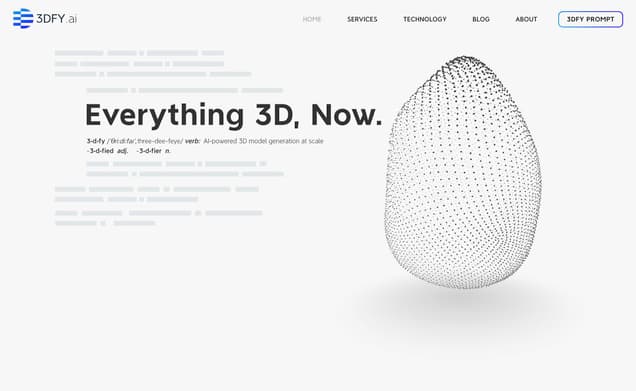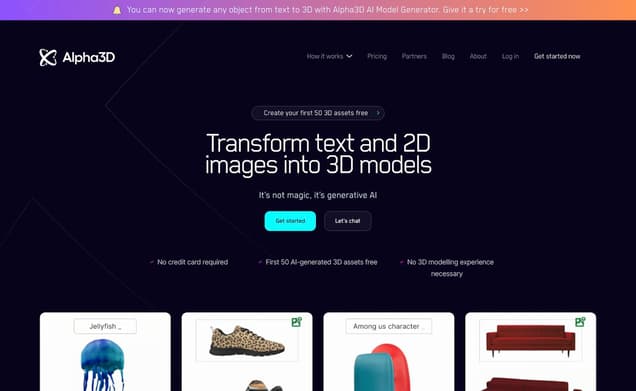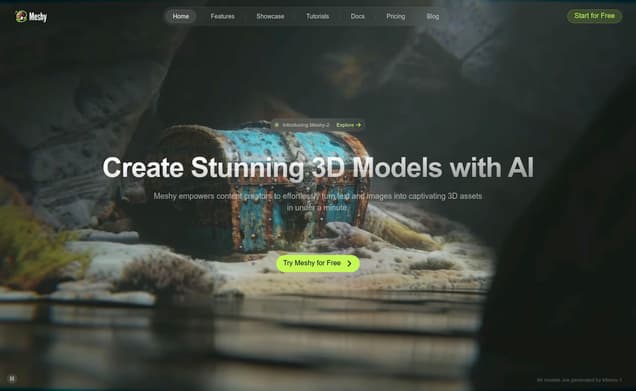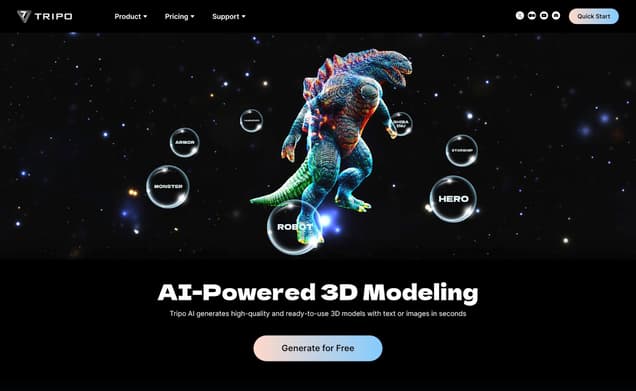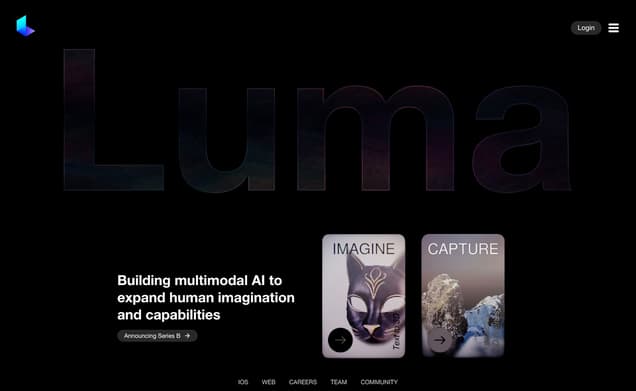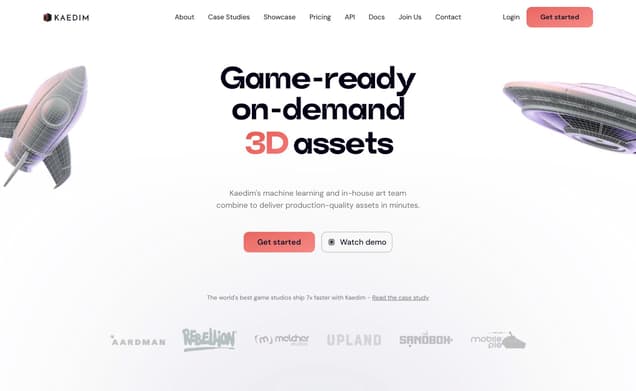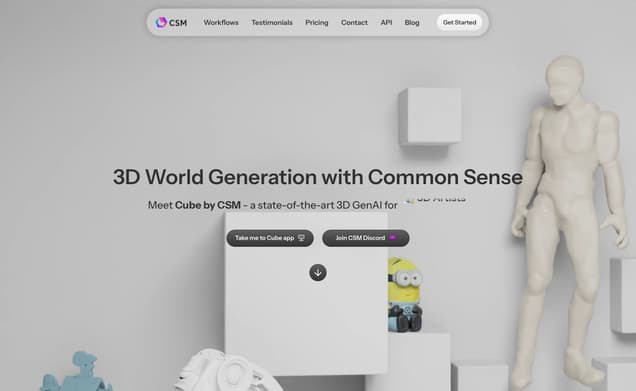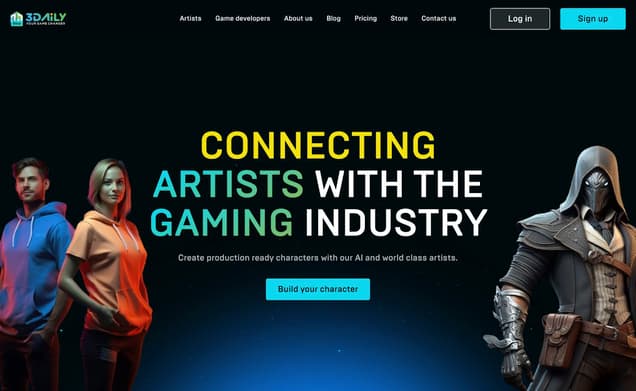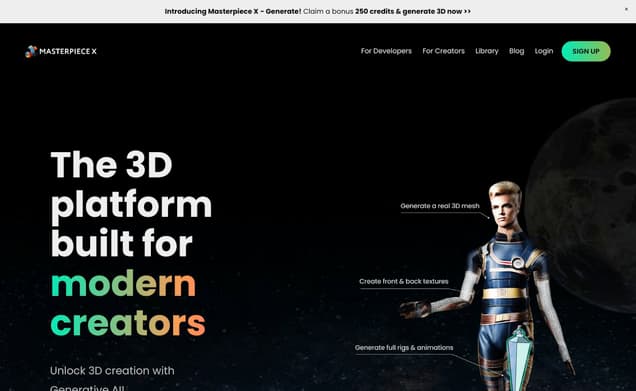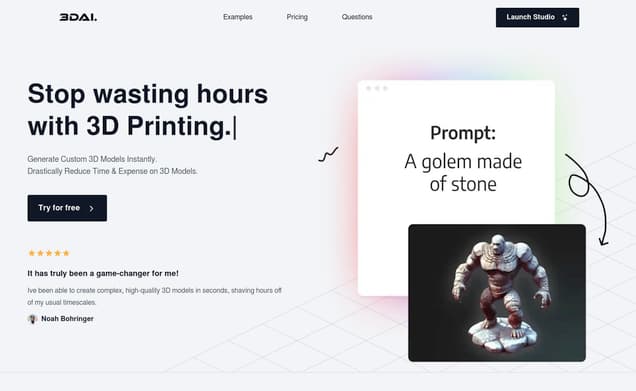Sloyd
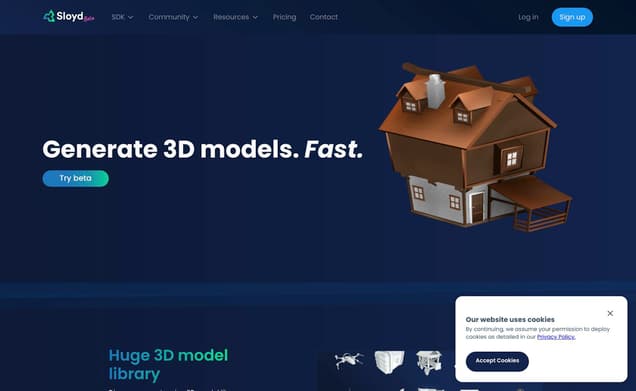
What is Sloyd ?
Sloyd, a pioneering 3D Generator, stands at the forefront of digital creativity, offering an intuitive platform for transforming text into detailed 3D models. This cutting-edge tool empowers users to generate a vast array of 3D assets, from game elements to architectural designs, seamlessly bridging the gap between conceptualization and visualization. With its user-friendly interface and robust technology, Sloyd democratizes 3D model creation, making it accessible to professionals and hobbyists alike, fueling imagination and innovation in the 3D space.
Features :
- Real-time generation of millions of unique 3D assets
- Extensive library of high-quality models
- Text-to-3D interface for customizable, game-ready 3D assets
- Automatic UV unwrapping and LODs for models
- Free and easy online 3D modeling experience
Pricing :
- Free Plan: Includes 30 export credits, access to generator library, and themed materials for personal and some commercial uses.
- Plus Plan: $20 per month, offering 200 export credits, full library access, and more, aimed at solo developers, artists, and small teams.
- Studio & Enterprise Plans: Custom pricing, offering additional credits, private generators, SDK access, and more for advanced needs.
Estimated Visit Traffic :
86.83K /MonthUser Distribution :
United States - 25.97% | United Kingdom - 9.5% | Germany - 3.53% | Russia - 2.96% | France - 2.88%Tags :
3d GeneratorExploring 3D Asset Customization with Sloyd AI
Welcome back to Blender Live! In this article, we dive into the innovative web app Sloyd AI. It's an asset customization tool where you can upload and tweak 3D models to suit your creative projects. Though its library currently has a limited selection, akin to a digital Lego set, its potential for enhancing your workflow is worth exploring.
1. Initial Impressions of Sloyd AI
Upon exploring Sloyd AI, the concept of customizing and exporting web-based 3D assets unfolds. The process of selecting and adjusting objects is intuitive, providing a promise for potential use in my own creative projects.,The customization feature in Sloyd AI is reminiscent of the Reality Composer app by Apple, offering a user-friendly way of stylizing objects before integrating them into other platforms like Blender or various game engines.,Sloyd AI's web-based platform means that you can use it on different devices, promoting accessibility and seamless integration with established 3D software.
2. The Current State of 3D Asset Libraries
Comparing Sloyd AI to other 3D asset aggregates, such as Sketchfab, the diversity and richness of available models vary greatly. While Sketchfab boasts an array of both stylistic and realistic assets, Sloyd AI is still in its infancy.,The value of 3D scans as reference material is undeniable. Using tools like Scanning or Polycam, one can create personal 3D models that serve as starting points or inspiration for projects.,Purchasable assets and the evolving accessibility of models suggest a future where shared 3D asset libraries become the norm in various industries, from gaming to interior design.
3. Integration and Usage within Creative Tools
The exported 3D models from Sloyd AI, currently limited to OBJ format without textures, demonstrate the tool's simplicity and room for growth. The subsequent application of materials and textures typically requires another layer of work within software like Blender.,The innovation in AI-driven tools like Dall-E and MidJourney has sparked imaginations, allowing artists to convert text prompts into conceptual art, which can act as powerful visual baselines for 3D composition.,How creative professionals incorporate these assets into their workflow, often using them as building blocks within more comprehensive 3D scenes, reflects the current synergy between human artists and technological tools.
4. Reader Engagement and Impressions
The enthusiastic response from readers indicates a broad intrigue and appreciation for the prowess and ease that Sloyd AI brings to the table in its early stages.,Confirmations of the author's Indonesian roots reflect the global reach and community around 3D asset creation and customization tools.
5. Vision for the Future of 3D Assets
Sloyd AI's potential to impact the 3D asset creation and customization landscape sparks interest. Its growth promises more comprehensive libraries and increased efficiency.,Integration with existing ecosystems and acceptance of various asset libraries will likely lead to a more connected and streamlined creative process for artists around the world.,Overall, the discussion around Sloyd AI taps into deeper questions about asset ownership, cultural representation in design, and the democratization of 3D asset creation.
6. Sloyd Video Summary
Sloyd AI represents an evolving step in 3D asset management, where customization and accessibility are keystone features. Despite its current limitations, such as a lack of textures and a nascent object library, Sloyd AI offers a window into a future where 3D assets are more readily shareable and adaptable. The importance of texture application, asset libraries like Sketchfab, and the broader context of 3D assets in creative industries also emerged as topics of discussion.
Other Sloyd Related Videos
User Reviews On Twitter
 SloydWe want to enable game developers to make bigger games in shorter time! With Sloyd, you can generate customizable 3D assets fast!We are opening up the tool we've been using internally to create 3D generators to the community. Those who join our Maker Pilot will get to improve their procedural skills, shape our product and could even make some money! Learn more and apply: sloyd.ai/maker/
SloydWe want to enable game developers to make bigger games in shorter time! With Sloyd, you can generate customizable 3D assets fast!We are opening up the tool we've been using internally to create 3D generators to the community. Those who join our Maker Pilot will get to improve their procedural skills, shape our product and could even make some money! Learn more and apply: sloyd.ai/maker/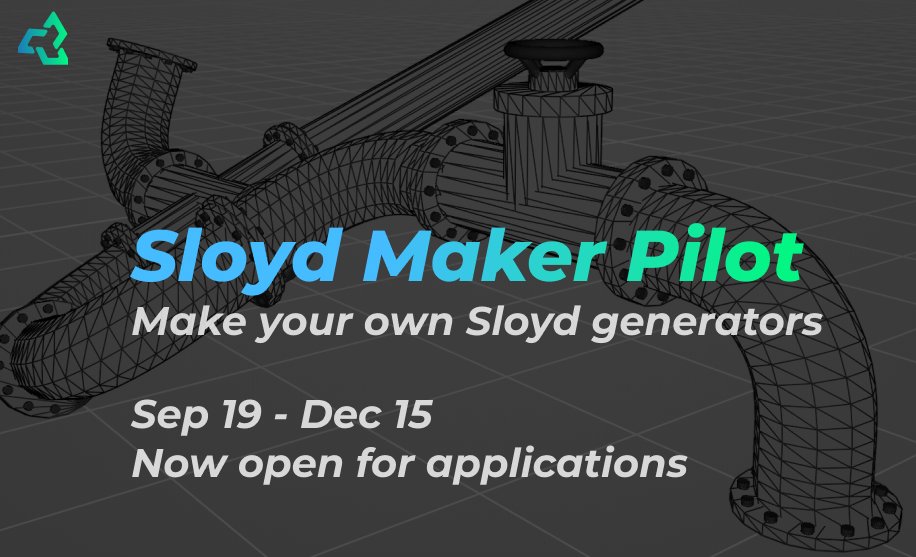
 SloydWe want to enable game developers to make bigger games in shorter time! With Sloyd, you can generate customizable 3D assets fast!Our biggest release of new generators until now! 20 new generators that you can customize to your liking, right in the Webapp. Go to sloyd.ai to try them out!
SloydWe want to enable game developers to make bigger games in shorter time! With Sloyd, you can generate customizable 3D assets fast!Our biggest release of new generators until now! 20 new generators that you can customize to your liking, right in the Webapp. Go to sloyd.ai to try them out!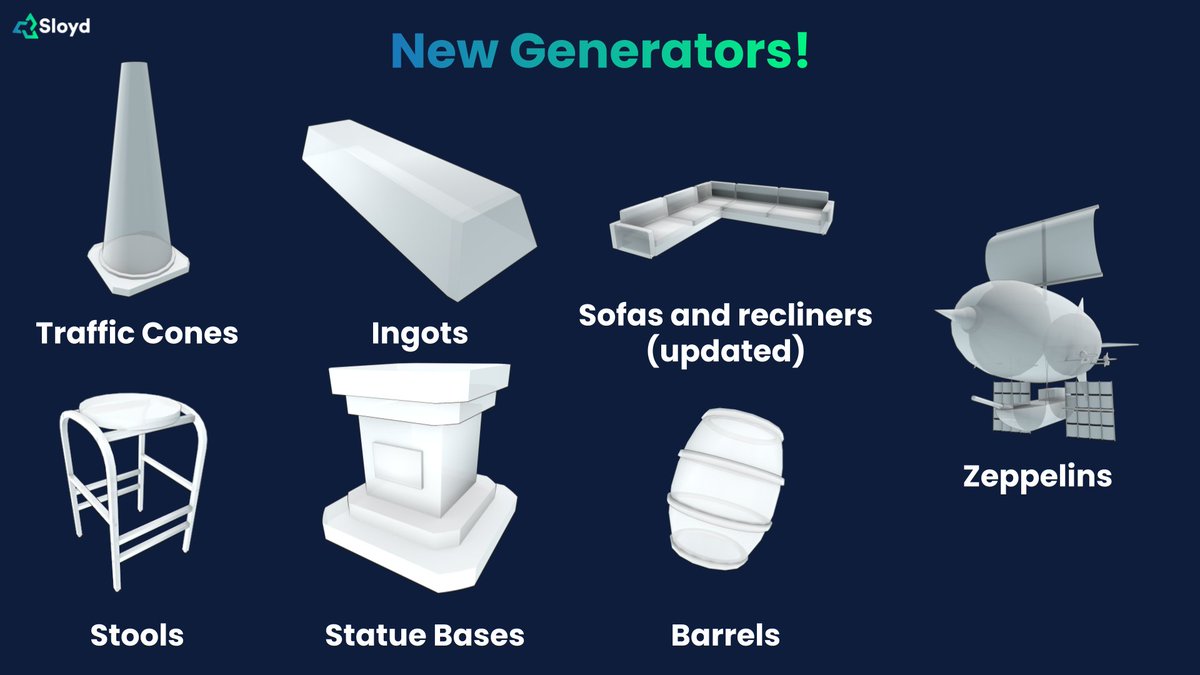
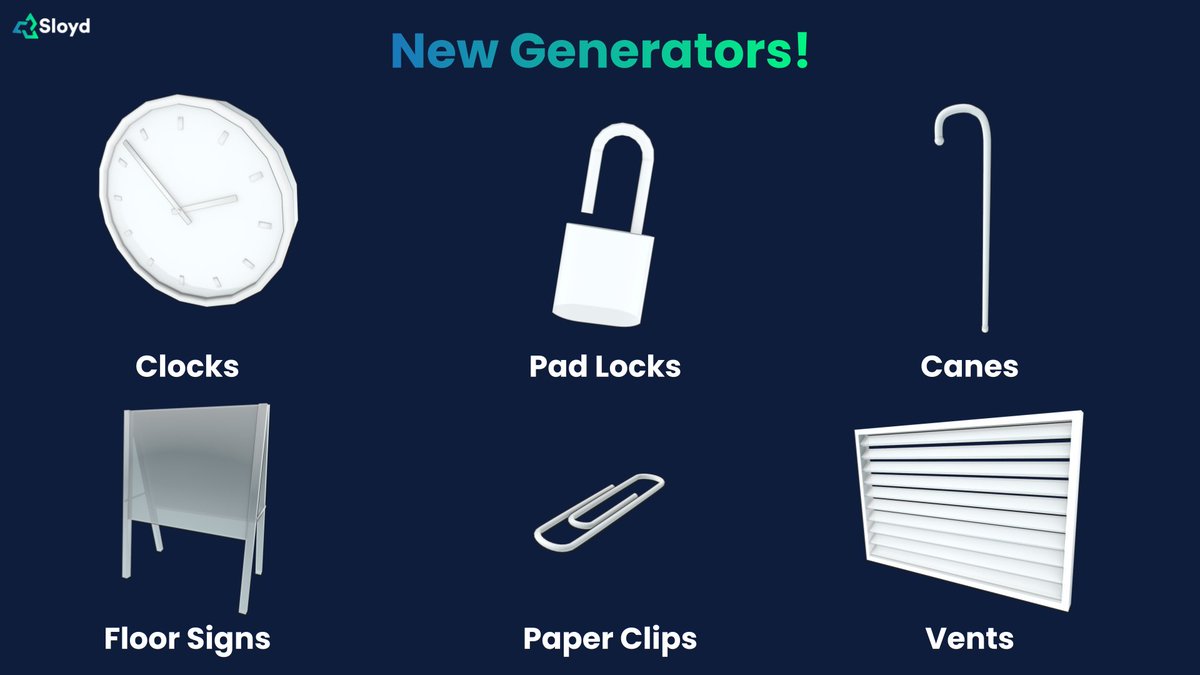
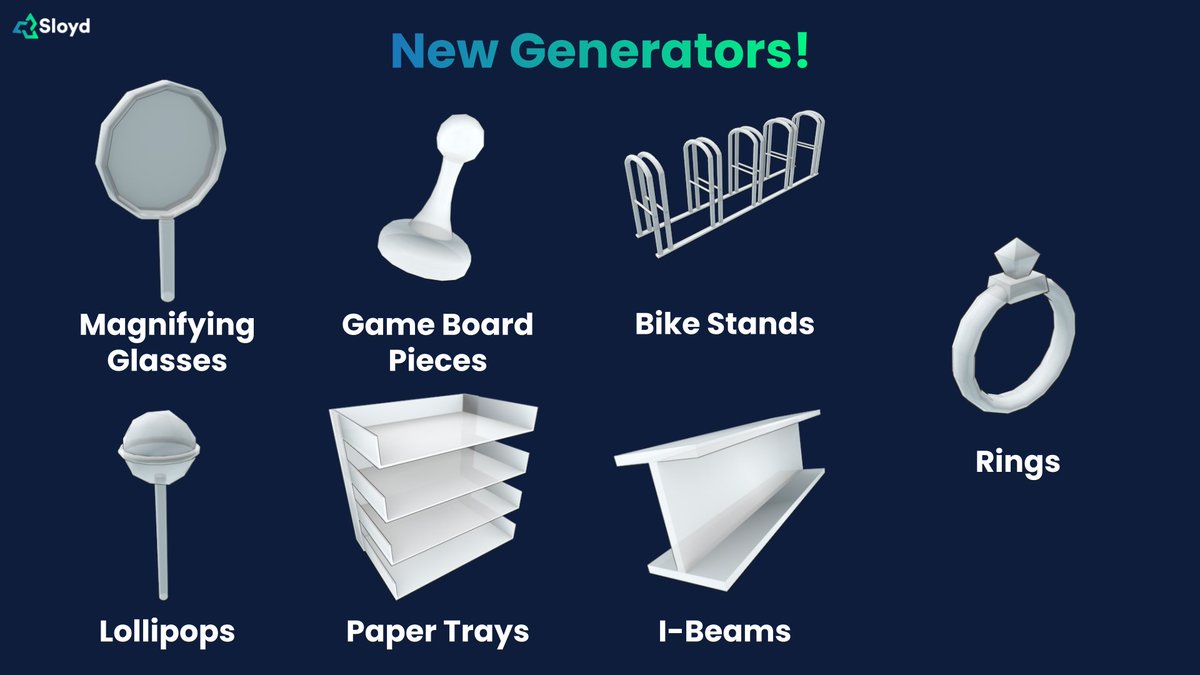
 LaminarFlowAutomate Your Content CreationPassive income in 5 minutes
LaminarFlowAutomate Your Content CreationPassive income in 5 minutes SloydWe want to enable game developers to make bigger games in shorter time! With Sloyd, you can generate customizable 3D assets fast!Another item drop today! 16 new generators in different themes: Urban, Construction, Park, and Playground.
SloydWe want to enable game developers to make bigger games in shorter time! With Sloyd, you can generate customizable 3D assets fast!Another item drop today! 16 new generators in different themes: Urban, Construction, Park, and Playground.
All of these have so many options 🤯 Try them out for yourself on app.sloyd.ai/ 🔍
#3d #procgen #3dart #gamedevs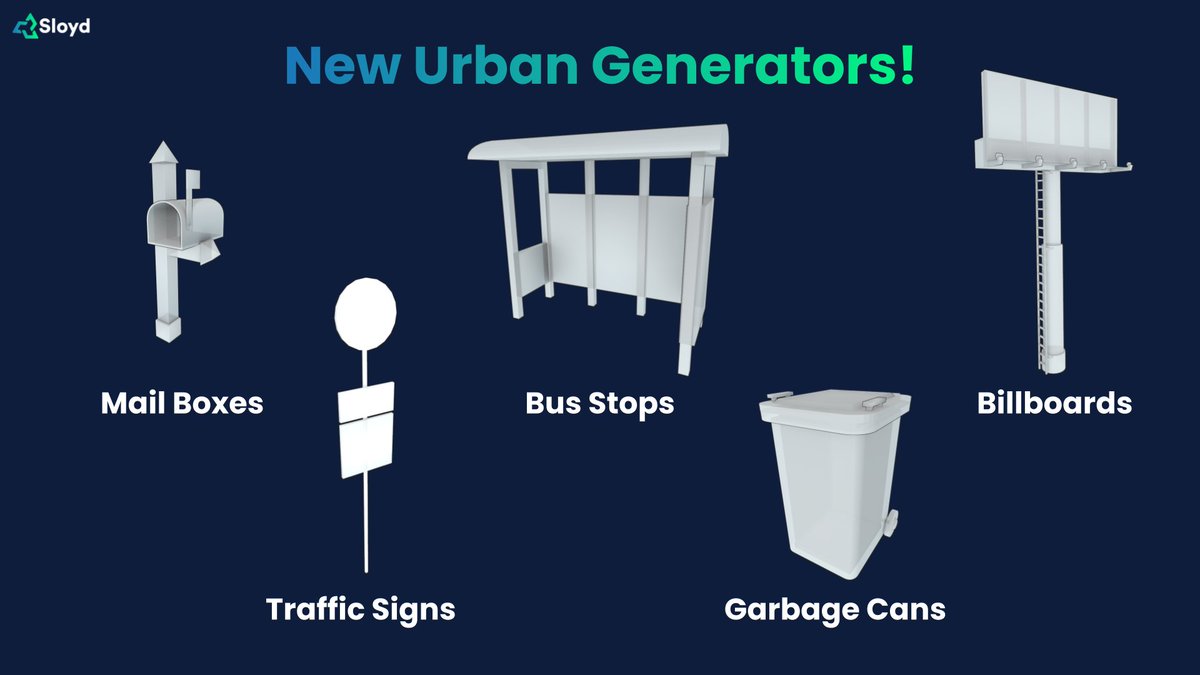
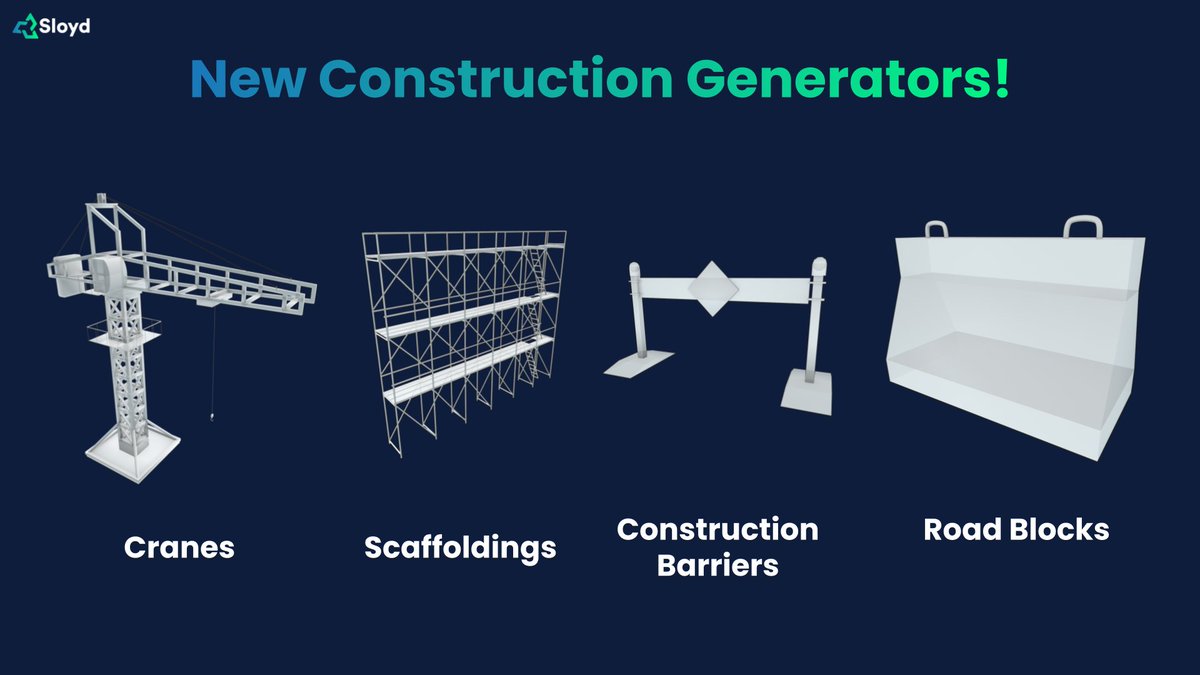
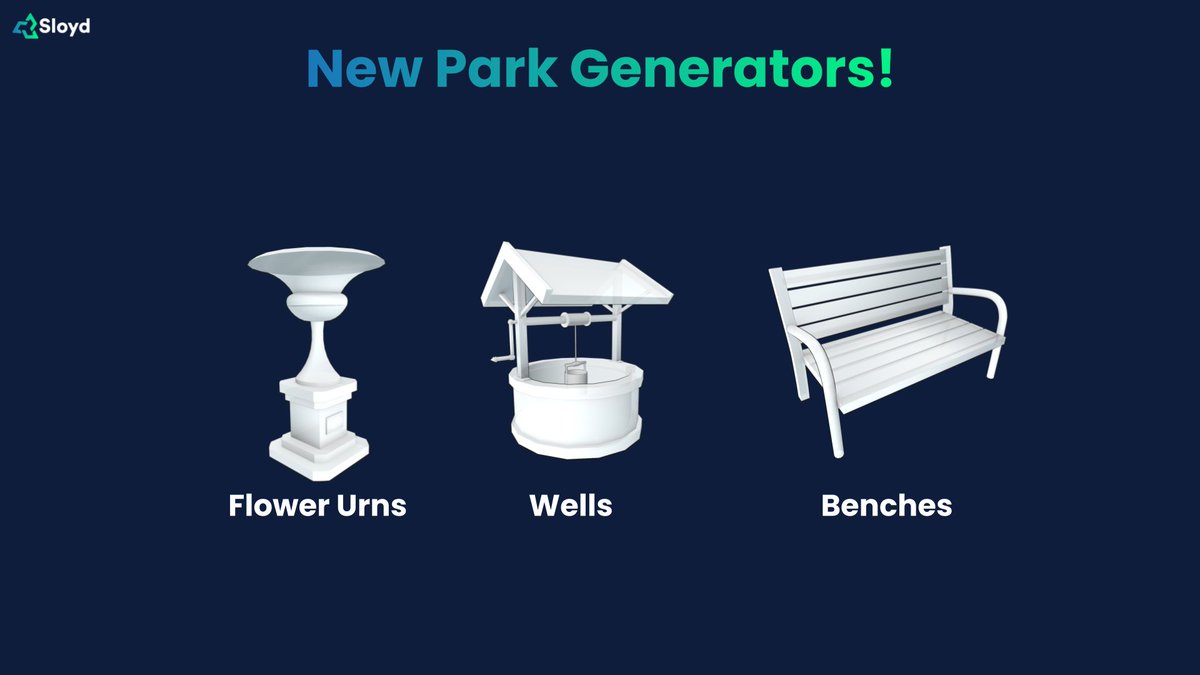
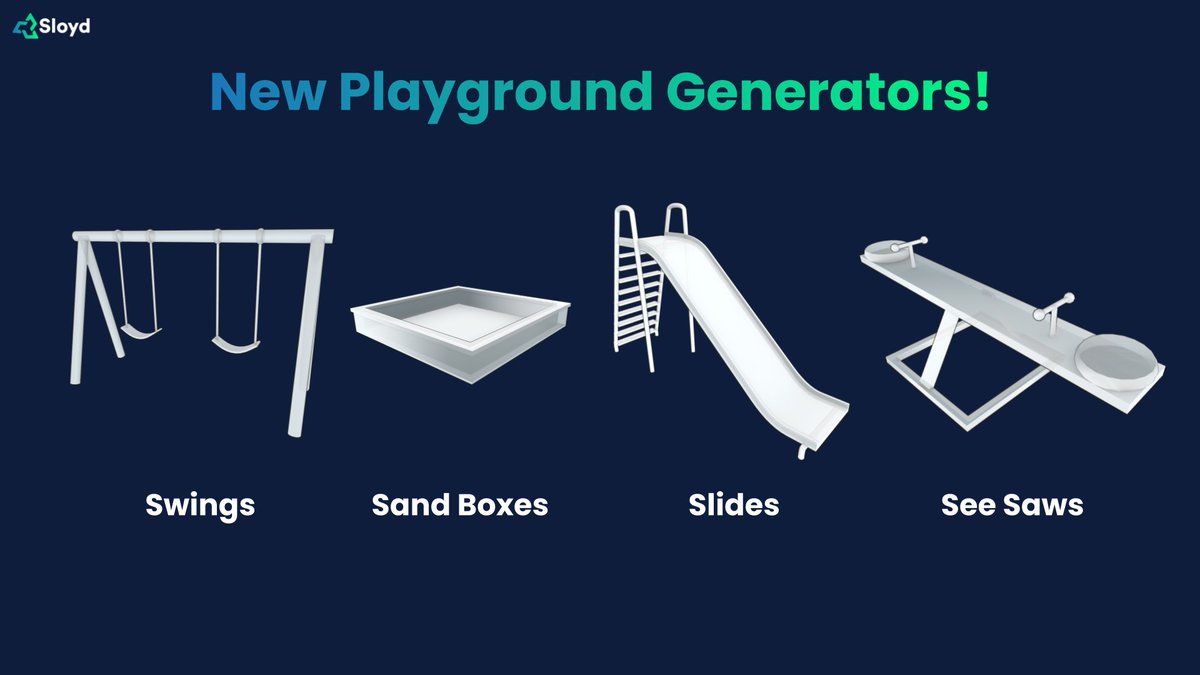
 phill.aiNot quite a robot yet, but I'm exploring AI and creating video, audio and text...the latter only when absolutely necessary.If you are a game developer, you know how time-consuming and challenging it can be to create 3D assets for your projects. You have to learn complex software, watch tutorials, model every detail, and optimize your assets... phill.ai/how-to-create-3d-assets-for-your-game-in-minutes-with-sloyd-ai/?utm_source=rss&utm_medium=rss&utm_campaign=how-to-create-3d-assets-for-your-game-in-minutes-with-sloyd-ai
phill.aiNot quite a robot yet, but I'm exploring AI and creating video, audio and text...the latter only when absolutely necessary.If you are a game developer, you know how time-consuming and challenging it can be to create 3D assets for your projects. You have to learn complex software, watch tutorials, model every detail, and optimize your assets... phill.ai/how-to-create-3d-assets-for-your-game-in-minutes-with-sloyd-ai/?utm_source=rss&utm_medium=rss&utm_campaign=how-to-create-3d-assets-for-your-game-in-minutes-with-sloyd-ai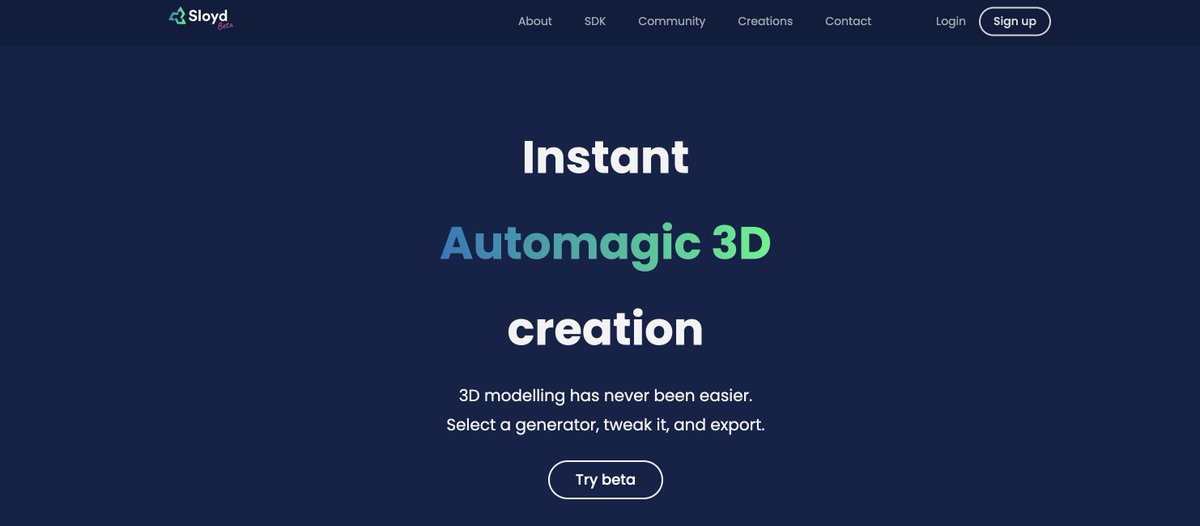
 Ikxi | Tatsunoko 🐉 | 3D Artist3D Artist / Hobby programmer https://t.co/OPx61CjrGR Kiryu Coco ♥️ Waiting 498 years for a shitty dragon kon Proud Tatsunoko 🐉 Eng/Deu PFP: @H2OHervida
Ikxi | Tatsunoko 🐉 | 3D Artist3D Artist / Hobby programmer https://t.co/OPx61CjrGR Kiryu Coco ♥️ Waiting 498 years for a shitty dragon kon Proud Tatsunoko 🐉 Eng/Deu PFP: @H2OHervida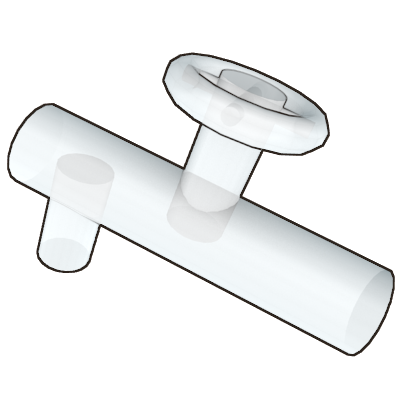
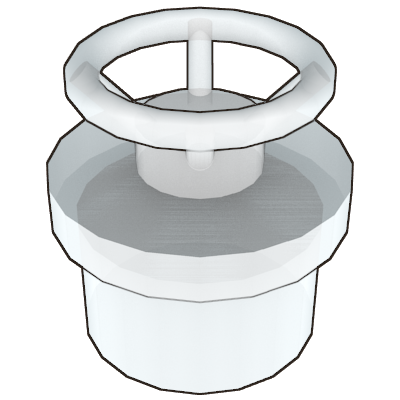
 Paris Peace Forum🌍 Fostering multi-actor solutions to address our world's greatest challenges🌐 Launched at the Paris Peace Forum back in November 2018, the Paris Call for Trust and Security in Cyberspace is based around 9 common principles which act as many areas for discussion and action to secure #cyberspace.
Paris Peace Forum🌍 Fostering multi-actor solutions to address our world's greatest challenges🌐 Launched at the Paris Peace Forum back in November 2018, the Paris Call for Trust and Security in Cyberspace is based around 9 common principles which act as many areas for discussion and action to secure #cyberspace.
Discover them all ↓ BhanuWriter & Designer • Sharing what I learn • Turning Creators into Creatorpreneurs • Generated 3 Million+ views and 5 figures in client revenue within 2 months 💸IMAGE / 3D
BhanuWriter & Designer • Sharing what I learn • Turning Creators into Creatorpreneurs • Generated 3 Million+ views and 5 figures in client revenue within 2 months 💸IMAGE / 3D
• Autoenhance.ai
• Trypencil.com
• Pixelvibe.com
• Sloyd.ai
• Botika.io
• Kaedim3d.com
• Hexo.ai Valentin RomainJe t’apprends à utiliser l’IA et 𝕏 pour générer 500€ de complément de revenus tous les mois • Tout en bossant 30min par jour max • Follow pour faire du fricNEW AI TOOLS
Valentin RomainJe t’apprends à utiliser l’IA et 𝕏 pour générer 500€ de complément de revenus tous les mois • Tout en bossant 30min par jour max • Follow pour faire du fricNEW AI TOOLS
@FineShare_Soft -> www.fineshare.com/
@RunDiffusion -> rundiffusion.com/
@SloydAi -> www.sloyd.ai/
@stewfortier -> type.ai/ Fractal Development LabsWe create custom mobile and web applications to empower startups and businesses| 🖥️ AI, XR and Web3Automatic 3D asset generator, Sloyd, has added material support and colors to their web app.
Fractal Development LabsWe create custom mobile and web applications to empower startups and businesses| 🖥️ AI, XR and Web3Automatic 3D asset generator, Sloyd, has added material support and colors to their web app.
www.sloyd.ai/
#sloyd #AIappDevelopment #AugmentedRealityApp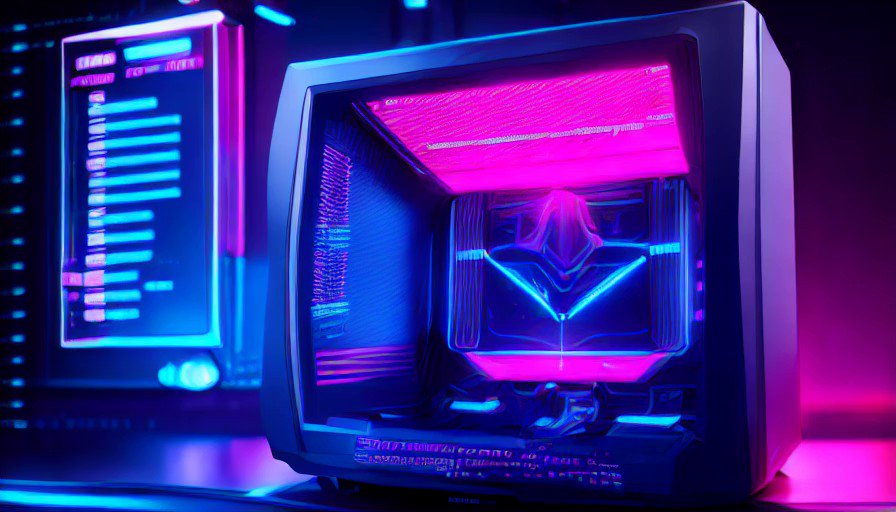
 SloydWe want to enable game developers to make bigger games in shorter time! With Sloyd, you can generate customizable 3D assets fast!Wondering how to prompt for the best results in Sloyd? We just put up a quick tutorial! www.sloyd.ai/blog/how-to-prompt-in-sloyd-generating-3d-assets
SloydWe want to enable game developers to make bigger games in shorter time! With Sloyd, you can generate customizable 3D assets fast!Wondering how to prompt for the best results in Sloyd? We just put up a quick tutorial! www.sloyd.ai/blog/how-to-prompt-in-sloyd-generating-3d-assets ChatDOCChatGPT-based file-reading assistant🤖 Quickly extract, locate and summarize information from docs.🚀 Citations are presented for fact-checking 🔍With ChatDOC, reading becomes simple! From research paper to financial reports, ask AI anything about your files, get instant answers with cited sources. Dive into documents with ease, grasp the gist, and enjoy seamless translations!
ChatDOCChatGPT-based file-reading assistant🤖 Quickly extract, locate and summarize information from docs.🚀 Citations are presented for fact-checking 🔍With ChatDOC, reading becomes simple! From research paper to financial reports, ask AI anything about your files, get instant answers with cited sources. Dive into documents with ease, grasp the gist, and enjoy seamless translations!
What users think about Sloyd - from Twitter
- Sloyd is expanding its community by inviting makers to join a pilot program, offering an opportunity to enhance procedural skills, influence product development, and possibly earn money.
- The platform recently launched a substantial update featuring 20 customizable new 3D generators accessible through its web application.
- Sloyd appeals to users by suggesting the possibility of generating passive income quickly, presumably through creating and monetizing 3D assets.
- A diverse selection of 16 new generators covering urban, construction, park, and playground themes was dropped, showcasing extensive customization options.
- Sloyd positions itself as a time-saving solution for game developers who typically invest significant effort in learning software, modeling, and optimizing 3D assets for their projects.
- The tool has been part of discussions and lists highlighting various AI tools and resources available to users interested in 3D modeling and other AI applications.
- Recent improvements to Sloyd include the addition of material support and colors, enhancing the capabilities of the automatic 3D asset generator.
Sloyd Pros and Cons
Pros :
- Intuitive and user-friendly interface
- Free access with generous monthly download credits
- Supports a wide range of 3D modeling needs
- Community-driven development and continuous innovation
Cons :
- Currently does not support image-to-3D model conversion
- Some advanced features require a paid subscription
Sloyd FQA
1. Can I use Text to 3D for generating 3D models with text prompts?
Yes, Sloyd specializes in converting text prompts into detailed 3D models, supporting a range of categories like buildings and props.
2. Does your platform use generative AI for creating 3D models?
Sloyd combines AI technologies with parametric generators for 3D modeling, creating a unique dataset for game-ready asset generation.
3. Can I generate 3D models for free?
Absolutely! Sloyd offers a range of downloadable 3D models at no cost, making 3D model generation accessible and easy.
Sloyd Use Cases
- Game development, providing assets such as buildings, props, and weapons
- Architectural visualization, offering tools for creating detailed structures
- 3D printing enthusiasts for creating unique designs
- Educational purposes, allowing students to explore 3D design
Similartool.ai Spotlight
Display Your Achievement: Get Our Custom-Made Badge to Highlight Your Success on Your Website and Attract MoreVisitors to Your Solution.




